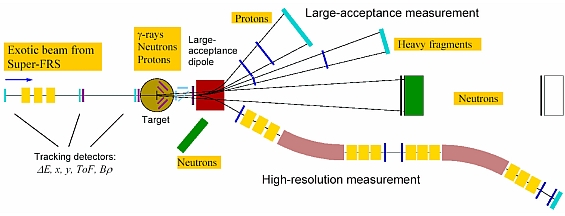Project Description
The R3B collaboration has designed the experimental setup (see below) capable of fully benefiting from the Super-FRS beams with the characteristics inherent to the in-flight production method. Located at the focal plane of the high-energy branch of the Super-FRS, R3B is a versatile fixed-target detector system with high efficiency, acceptance, and resolution for kinematically complete measurements of reactions with high-energy radioactive beams, even at very low beam intensities down to one ion per second.
Detectors will track and identify the beam onto a reaction target, typically liquid hydrogen, C or Pb, as well as after the target. The forward-going charged products and neutrons will be tracked, identified and momentum-analysed in a superconducting dipole magnet, time-of-flight walls and a neutron time-of-flight wall. Light charged particles and gamma rays from the target region will be measured by the target recoil detector. This detector surrounds the target volume and consists of two main elements: the Si tracker and the calorimeter. The Si tracker is a double-layer silicon micro-vertex tracker, providing precise tracking and vertex determination as well as energy and multiplicity measurement with high efficiency and acceptance. This will be surrounded by a scintillator-based calorimeter called CALIFA (CALorimeter for In-Flight emitted gAmma detection) for the full-energy detection of the light-ion ejectiles and gamma-ray detection. The target recoil detector is essential for a large part of the physics programme of R3B and, in particular, the light-ion induced studies such as quasi-free scattering that the UK is leading within the collaboration.
The UK will concentrate its effort on the target recoil detector. Specifically it will lead the design and construction of the Si tracker and its associated front-end electronics. It will also be responsible for the overall mechanical design for the target recoil detector and the target region in general. Specifically, the integration of the liquid hydrogen target, the Si tracker and the calorimeter will be led by the UK. The UK will also perform simulations of the performance of this combined detector system.


